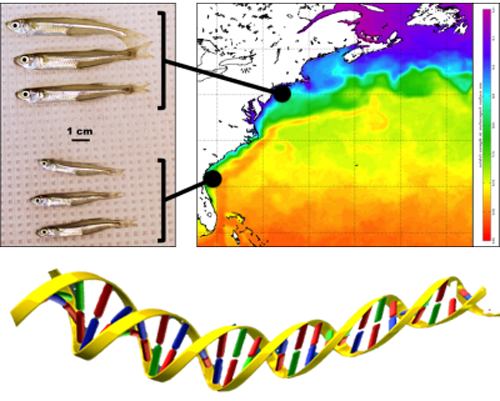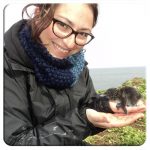We are overjoyed to announce that NSF is funding a new and collaborative research project to look at the genomic underpinning of local adaptation in the Atlantic silverside! Check out below for a first glimpse of the project website.

NSF-OCE #1756751 The genomic underpinnings of local adaptation despite gene flow along a coastal environmental cline (2018-2021)
Oceans are large, open habitats, where it was previously believed that the lack of obvious barriers to dispersal would result in extensive mixing, thereby preventing organisms from adapting genetically to particular habitats. It has recently become clear, however, that many marine species are subdivided into multiple populations that have evolved to thrive best under contrasting local environmental conditions. Nevertheless, we still know very little about the genomic mechanisms that enable divergent adaptations in the face of ongoing intermixing.
Learn more …
This project focuses on the Atlantic silverside (Menidia menidia), a small estuarine fish that exhibits a remarkable degree of local adaptation in growth rates and a suite of other traits tightly associated with a climatic gradient across latitudes. Decades of prior lab and field studies have made M. menidia one of the marine species for which we have the best understanding of evolutionary tradeoffs among traits and drivers of selection causing adaptive divergence. Yet, the underlying genomic basis is so far completely unknown.We will integrate whole genome sequencing data from wild fish sampled across the distribution range with breeding experiments in the laboratory to decipher these genomic underpinnings. This will provide one of the most comprehensive assessments of the genomic basis for local adaptation in the oceans to date, thereby generating insights that are urgently needed for better predictions about how species can respond to rapid environmental change. The project will provide interdisciplinary training for a postdoc as well as two graduate and several undergraduate students from underrepresented minorities. The findings will also be leveraged to develop engaging teaching and outreach materials (e.g. a video documentary and popular science articles) to promote a better understanding of ecology, evolution, and local adaptation among science students and the general public.
The project is organized into four interconnected components
Part 1 examines fine-scale spatial patterns of genomic differentiation along the cline to a) characterize the connectivity landscape, b) identify genomic regions under divergent selection, and c) deduce potential drivers and targets of selection by examining how allele frequencies vary in relation to environmental factors and biogeographic features.
Part 2 maps key locally adapted traits to the genome to dissect their underlying genomic basis.
Part 3 integrates patterns of variation in the wild (part 1) and the mapping of traits under controlled conditions (part 2) to a) examine how genomic architectures underlying local adaptation vary across gene flow regimes and b) elucidating the potential role of chromosomal rearrangements and other tight linkage among adaptive alleles in facilitating adaptation.
Part 4 examines dispersal – selection dynamics over seasonal time scales to a) infer how selection against migrants and their offspring maintains local adaptation despite homogenizing connectivity and b) validate candidate loci for local adaptation.









